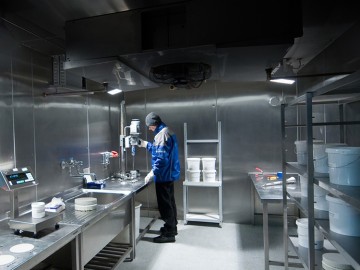
Test Like Crazy
There’s only one way to find out how cementitious construction materials behave under certain conditions: testing, testing and more testing. And that’s exactly what WACKER experts are doing at the technical competence center in Burghausen – and at other sites all over the world. Always with the aim of finding perfect formulations for unique applications.
One focus of the work at WACKER’s Burghausen Technical Center is on testing in accordance with current standards. The results of these tests serve as a basis for comparison while also allowing us to determine in advance whether a given formulation can obtain official certification.
We perform all of the definitive testing methods described in the relevant standards. We have also drawn on our many years of experience to develop some test methods of our own, providing our customers with even more insight into their products.
Tests for Tile Adhesives
We test the adhesion of tile adhesives to different substrates in the lab under specific environmental conditions. We also determine the wetting capability, open time and slip as a proxy for good processing properties. Flexibility is a further test area, as it is essential for ensuring that a tile adhesive can cope with thermal or mechanical stress.
Grout Tests
Our tests reveal whether a tile grout prevents water penetration and how it is affected by abrasive cleaning or thermal stress, among other things.
Tests for External Thermal Insulation Composite Systems (ETICS/EIFS)
The durability of external insulation composite systems is tested by determining the bond strength, flexibility and impact resistance of the embedding coat and adhesive mortar.
Tests for Renders/Plasters and Wall Troweling Compounds
Weatherability and UV resistance, water-repellency and mechanical strength are key properties of renders/plasters and wall troweling compounds. Our labs in Burghausen are fully equipped to test these properties in compliance with standard test methods.
Tests for Skim Coat/Wall Putties
Skim coat/wall putties are extremely versatile, finding application both indoors and outside – either as topcoats to smoothen surfaces or as a basis for paintwork and wallpaper. Our technical centers can conduct more than a dozen different types of tests to evaluate the performance and hydrophobic behavior of skim coat/wall putties.
Tests for Waterproofing Membranes
Waterproofing membranes are tested for their impermeability and their ability to bridge cracks. We employ different test methods to obtain the most robust information possible.
Tests for Self-Leveling Flooring Compounds
Self-leveling flooring compounds contain at least 10 ingredients. The formulations are complex and generally tailored to specific applications. Flowability, pumpability, drying time and emissions are just some of the criteria we check.
Check Us Out Today!
Take a closer look at our Burghausen technical competence center: our interactive PDF presents our equipment and labs and explains the tests and inspections performed here.
You can download our interactive PDF from the box below.




